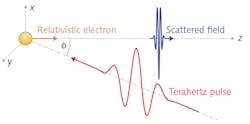Backscattering of terahertz pulses produces single-cycle attosecond pulses

Although single-cycle and subcycle attosecond-scale light pulses for physics and materials research have been created in a number of different ways, none of these ways allow the pulse shape to be controlled. Now, scientists at The University of Pećs (Pećs, Hungary) and ELI-ALPS (Szeged, Hungary) have come up with a theoretical proposal to do just this via Thompson backscattering of terahertz pulses in a very compact arrangement. The design contains a laser-plasma wakefield accelerator (LWPA) to produce a high-quality relativistic electron beam, and a terahertz light source capable of producing a single-cycle pulse. The electron beam from the LWPA is manipulated by magnetic devices to produce ultrathin slabs of relativistic electrons and the terahertz pulse is then backscattered off of the traveling slab, boosting the frequency of the light pulse by about a factor of 17,000 via the Doppler effect.
Because a LWPA can be a tabletop device, the whole single-cycle attosecond setup would fit within a small lab. In addition, the waveform of the resulting attosecond pulse closely resembles that of the original terahertz pulse, so customized attosecond waveforms would be easy to produce. Attosecond pulse energies would be on the order of 1 nJ. Reference: G. Tóth et al., arXiv:1711.05996v1 [physics.optics] (Nov. 16, 2017).

John Wallace | Senior Technical Editor (1998-2022)
John Wallace was with Laser Focus World for nearly 25 years, retiring in late June 2022. He obtained a bachelor's degree in mechanical engineering and physics at Rutgers University and a master's in optical engineering at the University of Rochester. Before becoming an editor, John worked as an engineer at RCA, Exxon, Eastman Kodak, and GCA Corporation.